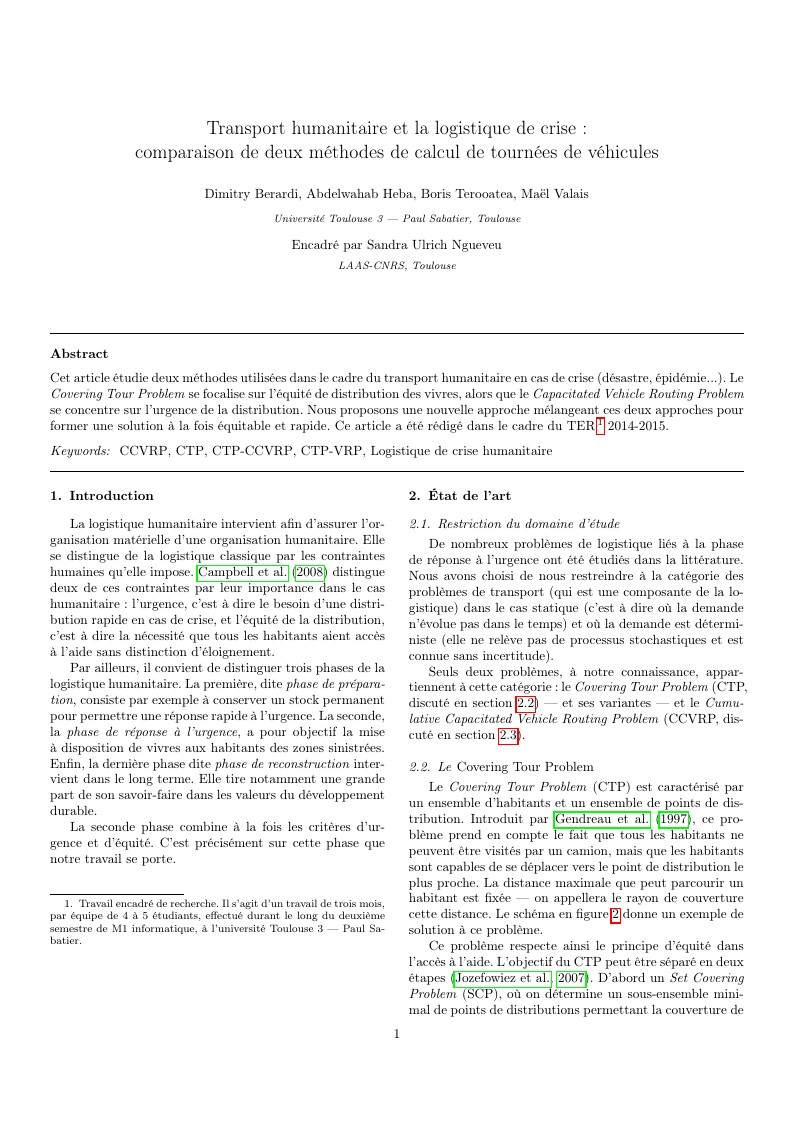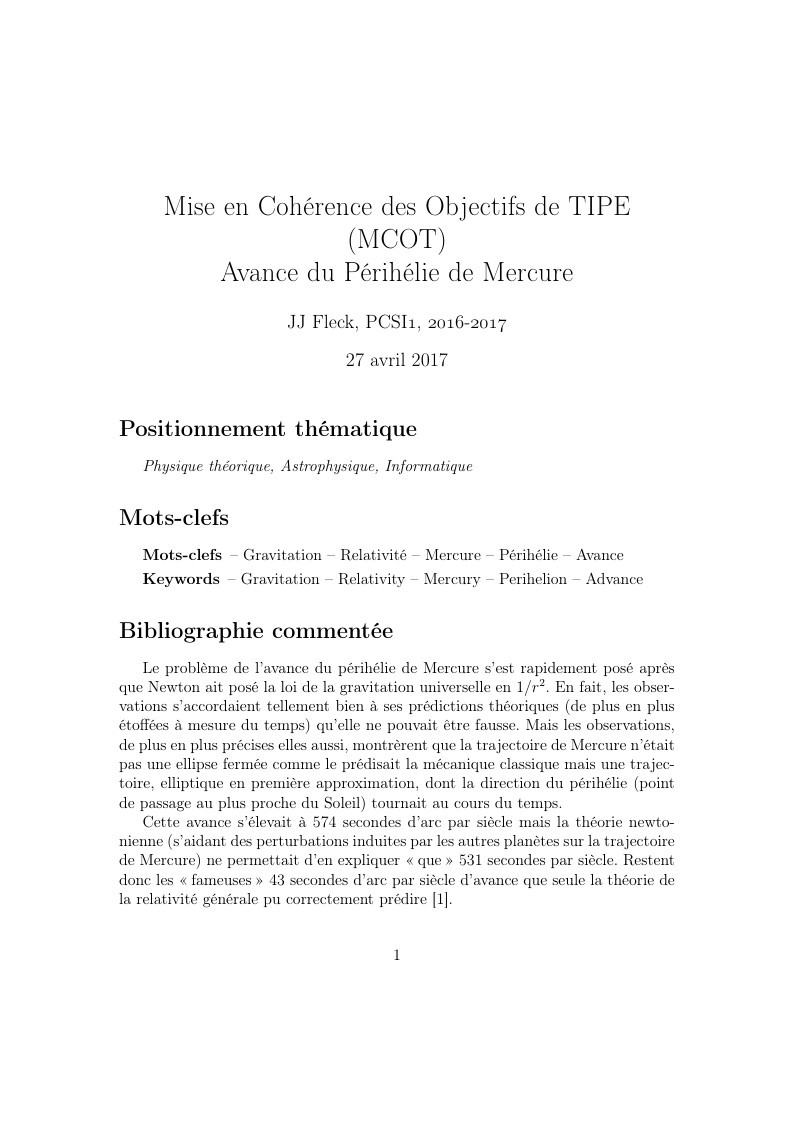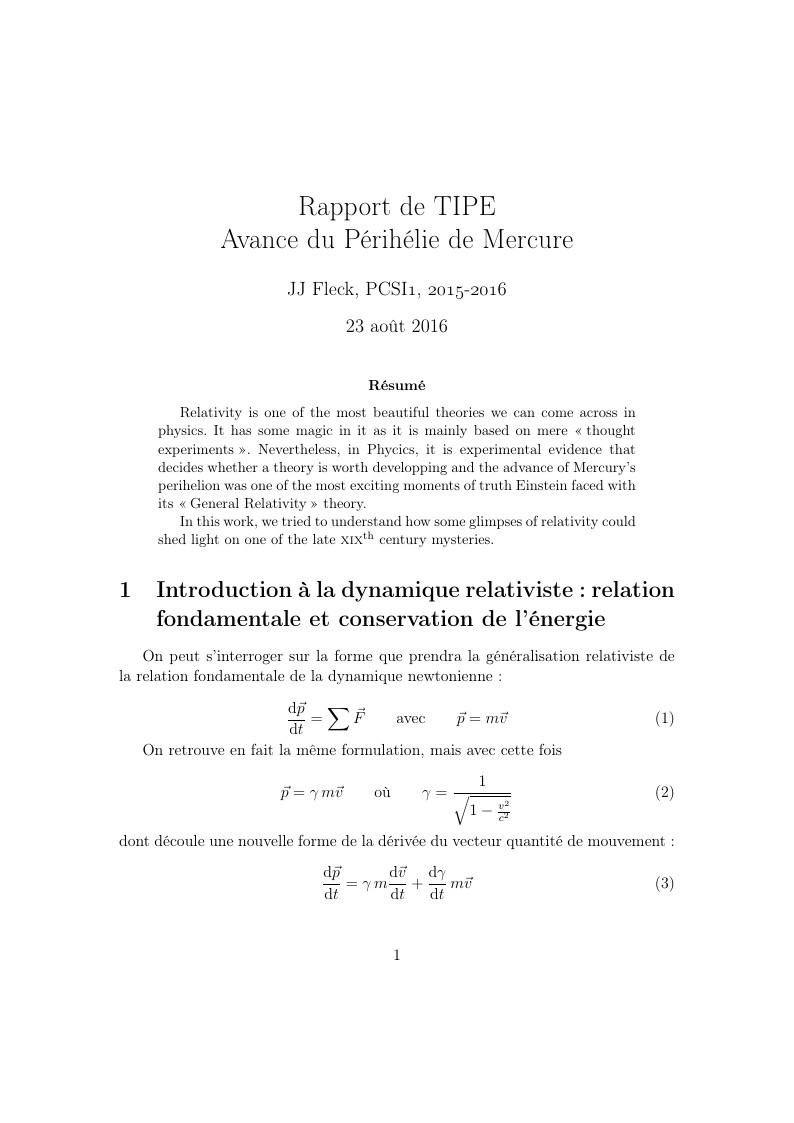Community articles — Conference Paper
Recent

Cet article étudie deux méthodes utilisées dans le cadre du transport humanitaire en cas de crise (désastre, épidémie...). Le Covering Tour Problem se focalise sur l'équité de distribution des vivres, alors que le Capacitated Vehicle Routing Problem se concentre sur l'urgence de la distribution. Nous proposons une nouvelle approche mélangeant ces deux approches pour former une solution à la fois équitable et rapide. Ce article a été rédigé dans le cadre du TER 2014-2015.

Exemple de MCOT pour les TIPE (Travaux d'Initiative Personnelle Encadrés) pour les concours d'entrée aux écoles d'ingénieurs à partir de la session 2017. L'idée est de laisser LaTeX gérer la bibliographie en la complétant au passage via l'utilisation de scholar.google.fr pour les recherches et la récupération des entrée BibTeX comme décrit dans cette vidéo.

Exemple de rapport pour les TIPE (Travaux d'Initiative Personnelle Encadrés) pour les concours d'entrée aux écoles d'ingénieurs à partir de la session 2017. Il y a surtout des exemples sur les différentes manières de composer des équations ainsi que comment introduire des portions de code Python pour illustrer son propos. NB: le script TeXcount pourra vous être utile car il permet de compter les mots utilisés dans chaque section d'un document LaTeX. Vous en trouverez une version en ligne à l'adresse http://app.uio.no/ifi/texcount/online.php Il suffit d'y copier l'ensemble du document (via Ctrl-A/Ctrl-C puis Ctrl-V dans la fenêtre idoine) pour obtenir le récapitulatif tout en bas de la page qui s'ouvre alors. (You can also get the word count in Overleaf by clicking on "Word Count" at the top of the file list panel.)

Paper presented at ICCV 2019. This paper targets the task with discrete and periodic class labels (e.g., pose/orientation estimation) in the context of deep learning. The commonly used cross-entropy or regression loss is not well matched to this problem as they ignore the periodic nature of the labels and the class similarity, or assume labels are continuous value. We propose to incorporate inter-class correlations in a Wasserstein training framework by pre-defining (i.e., using arc length of a circle) or adaptively learning the ground metric. We extend the ground metric as a linear, convex or concave increasing function w.r.t. arc length from an optimization perspective. We also propose to construct the conservative target labels which model the inlier and outlier noises using a wrapped unimodal-uniform mixture distribution. Unlike the one-hot setting, the conservative label makes the computation of Wasserstein distance more challenging. We systematically conclude the practical closed-form solution of Wasserstein distance for pose data with either one-hot or conservative target label. We evaluate our method on head, body, vehicle and 3D object pose benchmarks with exhaustive ablation studies. The Wasserstein loss obtaining superior performance over the current methods, especially using convex mapping function for ground metric, conservative label, and closed-form solution.

As LED systems have been evolving today in a great number of niche applications including automotive lighting, water purification, and skin imaging etc., extensive studies of scientists and engineers in the field have been constantly looking for ways to reduce generated heat loads and maximize the light output to reach the highest efficiency ratios. While the current systems developed over the last years achieved to reach even a 40% LED light efficiency, a higher portion of the electrical input energy of LEDs is still produced as heat and it hinders their development potential. In addition, the compact size of the LED systems poses some challenges to the reliable characterization of their performance at low uncertainties. Especially, the performance considerations associated with thermal loads over a limited size of LED chips require the effective characterization of these systems for various operational conditions. One of the techniques used for this purpose is that an LED package is characterized by a decrease in forward voltage with increasing junction temperature. As LEDs are operated at higher junction temperatures, the amount and quality of the light deteriorates significantly, and the less efficient use of the LEDs results in additional operating costs and reduced lifetime of LEDs. In fact, accurate identification of thermal behavior of LED packages is one of the essential tasks towards improving the design of LED systems. If thermal characterization of LEDs is accurately done, performance parameters of LED packages are more reliably optimized to yield the highest possible performance ratios. Thus, this study focused on the design and manufacturing of a thermally improved and fully operational rapid temperature controllable chamber in which calibration and test phases of junction temperature measurements are sensitively conducted under a low uncertainty.

In this paper novel approaches to optical beam shaping for lighting systems are presented. Application of various computer generated micro/nano-structured optical components is discussed.

Seoul Semiconductor’s patented nPola technology increases brightness levels 5 times over existing LEDs. This technology took more than 10 years to develop and is set to revolutionise the LED lighting industry. nPola stands for Numerous polarities and is related to the substrate in which the LED is grown. nPola is grown on a GaN (Gallium nitride) substrate, whereas conventional LEDs use Sapphire or Silicone substrate in which most of the energy is converted to heat instead of light due to a defect caused by lattice mismatch. nPola, however, does not have the lattice mismatch issue like conventional LEDs because the GaN epitaxy has the same crystalline structure as the GaN growth substrate. Furthermore, nPola technology involves the utilization of the one of the nPola non-polar planes in the GaN crystal, either the a-plane or m-plane, whereas traditional LEDs currently utilize the polar c-plane GaN epitaxy on Sapphire or Silicon. nPola LEDs offer reduced electrical resistance, increased electrical efficiency, reduction in colour shift with varying operating current and smaller device size. With nPola, Seoul Semiconductor has already improved the lumen density of LEDs by 5 times over the conventional LEDs based on equivalent die surface area and it expects to further improve this margin to 10 times in future.

The purpose of this paper is to examine how chronobiologically effective cabin lighting increases comfort and well-being for passengers on long-haul flights.
\begin
Discover why over 20 million people worldwide trust Overleaf with their work.